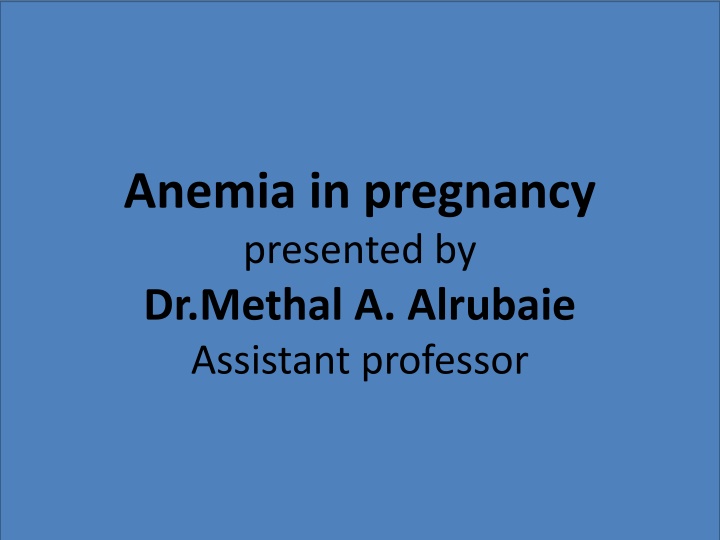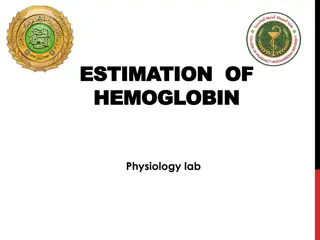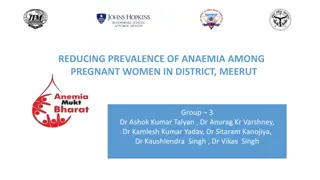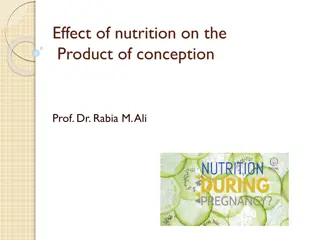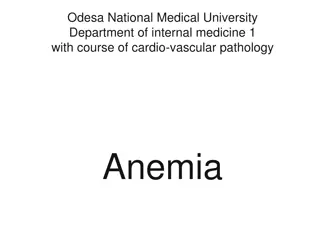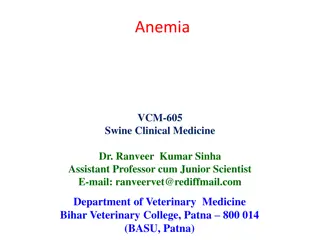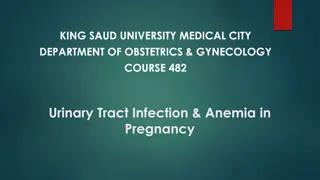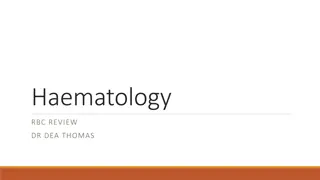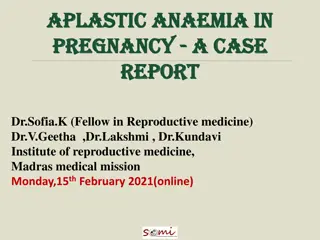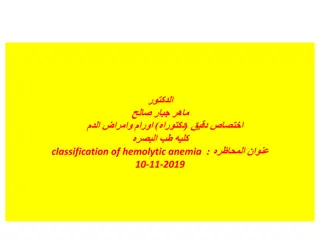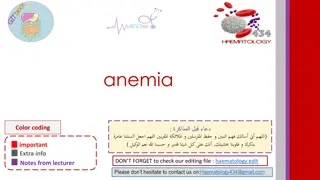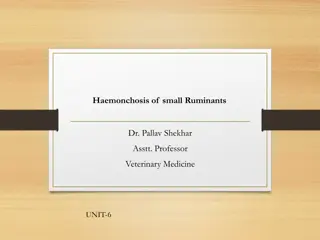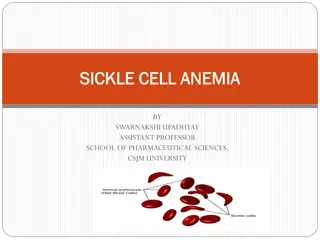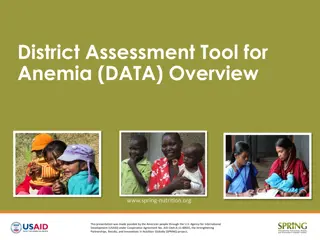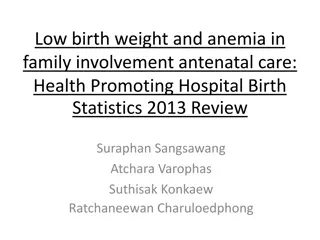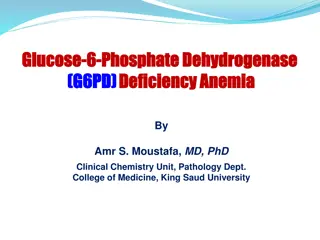Anemia in Pregnancy: Types, Etiology, and Management
Dr. Methal A. Alrubaie, an assistant professor, presents a detailed overview of anemia in pregnancy. The content covers the classification of anemia types, their etiology, clinical presentation, effects on both mother and fetus, investigation methods, and treatment approaches. Various types of anemia such as iron deficiency, folate deficiency, B12 deficiency, hemolytic anemia, thalassemia syndrome, and chronic anemia are discussed alongside risk factors and maternal risks associated with anemia during pregnancy.
Download Presentation

Please find below an Image/Link to download the presentation.
The content on the website is provided AS IS for your information and personal use only. It may not be sold, licensed, or shared on other websites without obtaining consent from the author.If you encounter any issues during the download, it is possible that the publisher has removed the file from their server.
You are allowed to download the files provided on this website for personal or commercial use, subject to the condition that they are used lawfully. All files are the property of their respective owners.
The content on the website is provided AS IS for your information and personal use only. It may not be sold, licensed, or shared on other websites without obtaining consent from the author.
E N D
Presentation Transcript
Anemia in pregnancy presented by Dr.Methal A. Alrubaie Assistant professor
Objectives Classify the types of anemia & explain the etiology behind each type. Describe how an anemic women presented clinically. Study the effect of anemia on both mother & fetus. Discuss the methods of investigations & treatment of each type.
Definition:- WHO defined anemia as hemoglobin level less than 11g/dl. Types:- A. Nutritional:- It include:- 1. Iron deficiency anemia. 2. Folate deficiency anemia. 3. B12 deficiency anemia. B. Hemolytic:- It include:- 1. Sickle cell syndrome:- it is subdivided into :- a. Sickle cell disease (HbSS). B. Sickle cell trait (HbAS). 2. Thalassemia syndrome:- a. Alpha thalaseemia. B. Beta thalassemia.
3. G6PD anemia. 4. Hereditory spherocytosis. 5. Auto-immune hemolytic anemia. C. Chronic anemia. Etiology:- 1.Iron deficiency anemia:- a. Decreased iron store. B. Decreased dietary intake c. Decreased intestinal absorption. D. Increased demand in pregnancy by increased red cell mass(500-600mg)& by fetus (300mg).
2. Folate deficiency anemia:- a. Decreased dietary intake. B. Increased renal clearance. C. Transfer to fetus (800Ug) at term. D. Increased demand in pregnancy by increased red cell mass & uterine hyperatrophy. 3. B12 deficiency anemia:- It is rare because it cause infertility. It arise due to dietary deficiency. 4. Sickle cell anemia:- There is qualitative defect in synthesis of hemoglobin molecule by substitusion of (valine) to (glutamic acid)amio-acid in position 6 of Beta chain.
5.Thalassemia syndrome:- There is quantitative defect in synthesis of either Alpha chain or Beta chain ,if there is deficiency in Alpha chain it cause Alpha thalassemia but if there is deficiency in Beta chains so cause Beta thalassemia. Both are subdivided into major & minor type. 6. G6PD anemia:- There is deficiency in enzyme glucose 6 pyruvate dehydrogenase which is involved in metabolism of red cells. 7. Chronic anemia:- It is caused by:- 1. chronic renal disease. 2. chronic liver disease. 3.Hook worm infestation. 4.Infection like Malaria,HIV.
Risk factors:- 1. Malnutrition. 2. Multiparty. 3. Low social class. 4. Poor education. 5. Short interval between pregnancy. 6. Prolong lactation. 7. Teen age. Maternal risk:- 1. Easy to get infection. 2. Difficult to perform usual work. 3. A.P.H. especially accidental hemorrhage in foliate deficiency.
4. PET especially in hemoglobinpathy. 5. P.P.H. 6. Recurrent U.T.I. 7. Delay recovery from anesthesia & wound infection. 8. Deep venous thrombosis. Fetal Risk:- 1. Congenital anomalies as N.T.D. ,cleft lip, cleft palate in foliate deficiency. 2. Preterm labor. 3. I.U.G.R. 4. I.U.D. 5.High perinatal mortality due to preterm delivery. 6. Neonatal anemia with behavioral changes.
Clinical features:- Symptoms:- 1.Headach & blurred vision. 2. Palpation & S.O.B. 3. Easy fatigue & intolerance to exercise. 4. Generalized bone pain. 5. Nausea & vomiting. 6. Fainting attack in sever anemia. 7. Numbness & paresthesia in B12 deficiency. Signs:- 1.Pallor discoloration of skin & mucous membrane. 2. Tachycardia& hypotension. 3. Ejection systolic murmur. 4.Angular stomatitis, loss of tongue papillae & tongue ulcer in foliate deficiency.
5. Jaundice & hepato-splenomegaly in hemoglobinpathy. 6. Low blood pressure & rapid pule rate. 7. Koilonychias in chronic type. Clinical features of sickle cell crisis:- 1.Sudden sever bone pain in upper & lower limbs. 2. Chest pain. 3. hematuria. 4. Sever pallor & jaundice. 5. Hypotension &tachycardia.
Investigations:- A. Iron deficiency anemia:- 1. Decreased serum ferritin level. 2. Decreased serum iron level. 3. Increased total iron binding capacity. 4. Blood film show microcytic (decreased MCV) & hypochromic(decreased MCHC). 5. Bone marrow show absence of stainable iron. B. Foliate deficiency anemia:- 1. Decreased serum foliate level. 2. Decreased red cell foliate level. 3. Decreased reticulocytes. 4. Blood film show macrocytic red cells(increased MCV) & hyper segmentation of nuclei of neutrophil.
5. Bone marrow show erythroblast & giant metamylocyte. C. B12 deficiency anemia:- There is decreased serum B12 level. D. Hemoglobinpathy:- 1. Increased reticulocytes & decreased platelets &WBC count. 2. Increased serum bilirubin level. 3. Presence of bile pigment & urobilinogen in urine. 4. Blood film show sickle shaped red cell when exposed to reducing agent or hypoxia (positive sickling test). 5. Normal MCV &MCHC but if these are low think about associated iron deficiency or thalassemia trait.
6. Hb electrophoresis is the definitive test to know the type, amount & character of Hb variant. Treatment:- A. Iron deficiency anemia:- Iron therapy is used either as:- 1. Prophylactic:- It is given to asymptomatic pregnant patient to prevent development of anemia as pregnancy increased demand. It is usually started in second trimester. 2. Therapeutic:- It is given to symptomatic pregnant anemic women. Iron therapy can be given either as:-1. Oral iron:- It present as Ferrous sulphate which supply (67mg) of elemental iron in 200mg tablet .It is given three times daily. It is easily absorbed.
Other oral preparation are ferrous fumerate & ferrous gluconate which supply 37mg of elemental iron in 200mg tab. Nausea, vomiting & constipation are common side effects. Such oral iron can be given if anemia develop earl in pregnancy. 2. Parental iron:- It is indicated in:- a. Poor iron absorption. B. Poor compliance of patient. C. Intolerance to side effect. Parental iron can be Iron dextran (Inferon) given as I.V. bolus dose or as infusion or Iron sorbitol (jectofer) given as I.M. The total dose is calculated as 1.3xB.W.xHb deficit.
Both oral & parental iron have same efficacy & response is assess by rise in Hb level by 1-2g/dl within two weeks. Blood transfusion is indicated when anemia develop in late pregnancy & Hb is 8g/dl or less. B. Foliate deficiency anemia:- It is given either as prophylactic (1mg) tab. daily. Or as therapeutic (5mg) tab. oral tablets. It is also indicated in those with sickle cell disease even before pregnancy as 5mg tab. Twice daily. Pre- pregnancy use of folic acid can reduce N.T.D. Folic acid tab. Is indicated as soon as pregnancy diagnosed.
C. B12 deficiency anemia:- Parental B12 ampoule (1000Ug) is given once weekly. D. Hemoglobinpathy:- *Oral folic acid 5mg twice daily. * Iron therapy can be given in sickle cell trait & thalassemia minor but contraindicated in sickle cell disease since it cause hemosiderosis. *Screening for U.T.I. & treatment. *Antepartum blood transfusion is indicated to keep normal Hb(HbA) constitute 60% of whole Hb. It is given either as prophylactic or selective when Hb level is less than 8g/dl.
*Discontinue (hydroxyurea) drug which increase HbF, improve red cell hydration & decrease polymerization of HbS since it is teratogenic. Treatment of sickle cell crisis:- *Adequate hydration. * Adequate oxygen supply. * Adequate analgesia & pain killer. * Treatment of infection any where. * Blood transfusion. * No indication for termination of pregnancy.
Labor management:- * Keep the patient warm. * Adequate I.V. glucose water infusion to prevent dehydration & provide energy. * Blood transfusion if Hb level is 8g/dl or less. * Monitering of fetal heart since the fetus is under stress due to hypoxia. * Avoid prolong labor. * Early mobilization & chest physiotherapy after C/S. * Thrombo-prophylaxis for those immobilized & those who develop crisis. * Anemia alone is not indication for C/S.
